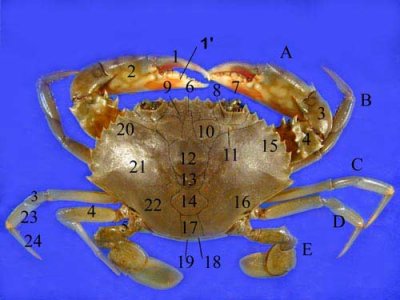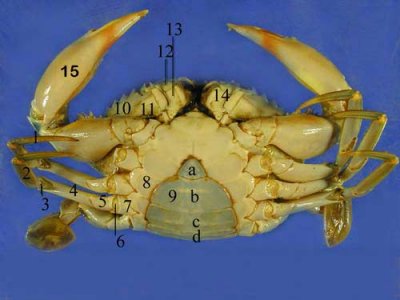![]() General Morphology: dorsal view, ventral view
General Morphology: dorsal view, ventral view
![]() Families: Portunidae.
Families: Portunidae.
Dorsal View

1. Movable finger
2. Manus
3. Carpus
4. Merus
5. Ischium
6. Frontal region
7. Orbital region
8. Eyestalk
9. Epigastric region
10. Propogastric region
11. Hepatic region
12. Mesogastric region
13. Metagastric region
14. Cardiac region
15. Anterolateral margin
16. Posterolateral margin
17. Intestinal region
18. Posterior margin
19. Abdomen
20. Protobranchial region
21. Mesobranchial region
22. Metabranchial region
23. Propodus
24. Dactylus
A . Cheliped
B. Immovable finger
C - E. Ambulatory legs
Ventral View

2. Propodus
3. Carpus
4. Merus
5. Ischium
6. Basis
7. Coxa
8. Thoracic
9. Abdomen
10. Subhepatic region
11. Pterygostomian region
12. Merus of third maxilliped
13. Ischium of third maxilliped
14. Third maxilliped
15. Manus
a. Seventh sternite
b. Sixth sternite
c. Fifth sternite
d. Fourth sternite
Family Portunidae
The Portunidae includes most of the crab species caught both commercially and by amateurs. Portunids attain large sizes and are renowned for their culinary properties. These crabs can be recognised by the broardly flattened last pair of legs, which adapt to swimming. Carapace depressed or slightly convex (except for a few), usually broader than long. Front broad, not deflected downwards; generally produced horizontally in lobes or teeth. Right chela often larger than the left. Usually a small lobe at inner angle of endopodite. There are numerous species of portunids, especially in tropical seas, mostly in the genera Portunus, Thalamita, and Charybdis.